Renard 64XC Construction: Difference between revisions
| Line 3: | Line 3: | ||
::'''Note:''' Pictures are being added daily and the sequence is changing based on an actual assembly. | ::'''Note:''' Pictures are being added daily and the sequence is changing based on an actual assembly. | ||
:The following sequence of steps is by no means the only way to | :The following sequence of steps is by no means the only way to assemble the Renard 64. It is simply a suggested order of assembly. Many builders have varied opinions on what the order should be. In general, you start with the "shortest" items and work towards the tallest. This generally means that resistors are first and connectors are last but every board is different. | ||
:A good temperature controlled soldering iron should be used for building the Renard 64. Try to get the smallest diameter rosin core solder you can find (either 60/40 or 63/37). DO NOT USE LEAD FREE SOLDER!! This takes special equipment and a very high skill set that few DIYers have. If you do use Lead Free Solder and have problems (which is VERY likely) please let us know when you ask for help. Lead Free Solder can look like a good joint but still | :A good temperature controlled soldering iron should be used for building the Renard 64. Try to get the smallest diameter rosin core solder you can find (either 60/40 or 63/37). PLEASE DO NOT USE LEAD FREE SOLDER!! This takes special equipment and a very high skill set that few DIYers have. If you do use Lead Free Solder and have problems (which is VERY likely) please let us know when you ask for help. Lead Free Solder can look like a good joint but still be a problem. | ||
:One safety note is prudent here. Solder is METAL (lead and tin)...In order to use it,it must be MELTED. HOT, Molten Metal can BURN! Also, metal leads get hot while soldering. So, any unprotected fingers that are being used to "hold" a component in place will be burned!! Painter's tape is one way of holding items down while the board is being flipped over. Another way is to use another unpopulated board or flat surface to allow the board to be flipped while keeping the components in place. | :One safety note is prudent here. Solder is METAL (lead and tin)...In order to use it,it must be MELTED. HOT, Molten Metal can BURN! Also, metal leads get hot while soldering. So, any unprotected fingers that are being used to "hold" a component in place will be burned!! Painter's tape is one way of holding items down while the board is being flipped over. Another way is to use another unpopulated board or flat surface to allow the board to be flipped while keeping the components in place. | ||
| Line 55: | Line 55: | ||
|| [[Image:Renard 64XC D1-D4 Install.jpg | 200px]] | || [[Image:Renard 64XC D1-D4 Install.jpg | 200px]] | ||
|- | |- | ||
|<center>'''INSTALLATION NOTE:''' </center> | !colspan="2"|<center>'''INSTALLATION NOTE:''' </center> | ||
<blockquote>The next few items are all very close to the same height. If in doubt which one is right, compare the components and change the order as appropriate. The order here follows the pictures and the specific components used. Part substitutions can affect this as well so if in doubt, check.</blockquote> | <blockquote>The next few items are all very close to the same height. If in doubt which one is right, compare the components and change the order as appropriate. The order here follows the pictures and the specific components used. Part substitutions can affect this as well so if in doubt, check.</blockquote> | ||
<blockquote>Also, for the sockets, Pin 1 must be aligned with the square solder pad. Another way to verify that you installed them correctly is to make sure that the notch on the socket is aligned with the notch on the PCB silkscreen outline. </blockquote> | <blockquote>Also, for the sockets, Pin 1 must be aligned with the square solder pad. Another way to verify that you installed them correctly is to make sure that the notch on the socket is aligned with the notch on the PCB silkscreen outline. </blockquote> | ||
| Line 73: | Line 72: | ||
|| [[Image:Renard 64XC U4-U14 Socket Install.jpg | 200px]] | || [[Image:Renard 64XC U4-U14 Socket Install.jpg | 200px]] | ||
|- | |- | ||
|<center>'''INSTALLATION NOTE:''' </center> | !colspan="2"|<center>'''INSTALLATION NOTE:''' </center> | ||
<blockquote>The following resistor network is a "bussed" type resistor network. This means that the seven (7) resistor components (pins 2-8) are all connected in a common buss to pin 1. Installing the resistor network backwards will cause a multitude of malfunctions. So please take the time to make sure they are installed correctly.</blockquote> | <blockquote>The following resistor network is a "bussed" type resistor network. This means that the seven (7) resistor components (pins 2-8) are all connected in a common buss to pin 1. Installing the resistor network backwards will cause a multitude of malfunctions. So please take the time to make sure they are installed correctly.</blockquote> | ||
|- | |- | ||
| Line 97: | Line 96: | ||
|- | |- | ||
| | | | ||
The BOM calls | * The original Renard 64XC BOM calls for spades here. However, many users prefer to use a single 2 position terminal here. Install one (1) two position terminal block for 6.3VAC input. | ||
|| [[Image:Renard 64XC Terminal Install.jpg | 200px]] | || [[Image:Renard 64XC Terminal Install.jpg | 200px]] | ||
|- | |- | ||
| Line 128: | Line 127: | ||
|| [[Image:Renard 64XC C1 Install.jpg| 200px]] | || [[Image:Renard 64XC C1 Install.jpg| 200px]] | ||
|- | |- | ||
!colspan="2" |<blockquote> If you are unsure about your ability to build this board, then you should go to [[Beginners_Setup_Guide_Renard_Boards_with_External_SSR | The Beginner's Setup Guide]] at this point. [[Beginners_Setup_Guide_Renard_Boards_with_External_SSR | The Beginner's Setup Guide]] will walk you thru some initial tests to make sure that everything is working correctly before inserting the IC chips. </blockquote> | |||
|- | |- | ||
|<center>'''INSTALLATION NOTE:''' </center> | !colspan="2"|<center>'''INSTALLATION NOTE:''' </center> | ||
<blockquote>Pin 1 of each IC must be aligned with pin 1 of the corresponding socket. This can be verified by noting that the notch on the IC is aligned with the notch on the socket. | <blockquote>Pin 1 of each IC must be aligned with pin 1 of the corresponding socket. This can be verified by noting that the notch on the IC is aligned with the notch on the socket. | ||
|- | |- | ||
Revision as of 13:05, 31 August 2010
Board Assembly
- Note: Pictures are being added daily and the sequence is changing based on an actual assembly.
- The following sequence of steps is by no means the only way to assemble the Renard 64. It is simply a suggested order of assembly. Many builders have varied opinions on what the order should be. In general, you start with the "shortest" items and work towards the tallest. This generally means that resistors are first and connectors are last but every board is different.
- A good temperature controlled soldering iron should be used for building the Renard 64. Try to get the smallest diameter rosin core solder you can find (either 60/40 or 63/37). PLEASE DO NOT USE LEAD FREE SOLDER!! This takes special equipment and a very high skill set that few DIYers have. If you do use Lead Free Solder and have problems (which is VERY likely) please let us know when you ask for help. Lead Free Solder can look like a good joint but still be a problem.
- One safety note is prudent here. Solder is METAL (lead and tin)...In order to use it,it must be MELTED. HOT, Molten Metal can BURN! Also, metal leads get hot while soldering. So, any unprotected fingers that are being used to "hold" a component in place will be burned!! Painter's tape is one way of holding items down while the board is being flipped over. Another way is to use another unpopulated board or flat surface to allow the board to be flipped while keeping the components in place.
- NOTE: The part numbers referenced in the following instructions are those taken from the Renard 64 BOM.
| |
|
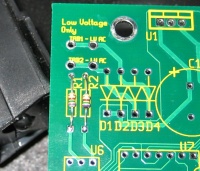
|
|
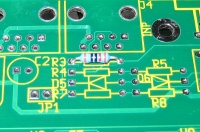
|
|
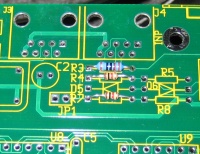
|
|

|
|
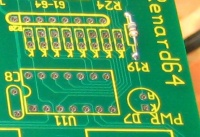
|
|
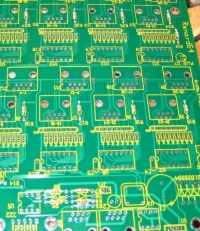
|
|
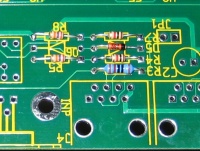
|
|
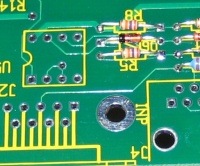
|
|
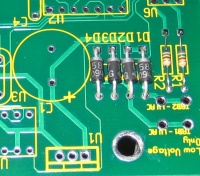
|
| |
|
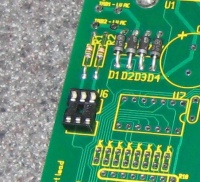
|
|
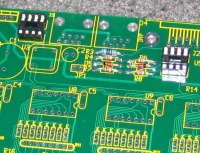
|
|
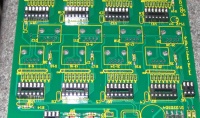
|
| |
|

|
|
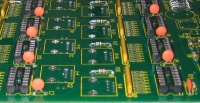
|
|

|
|

|
|
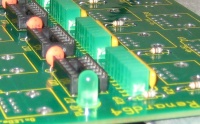
|
|
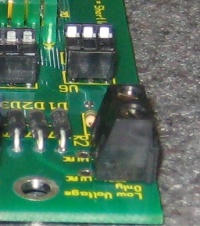
|
|
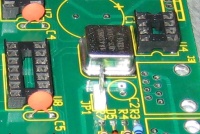
|
|
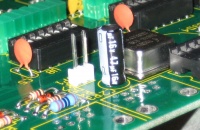
|
|
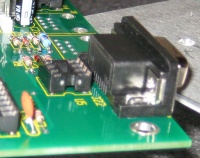
|
|
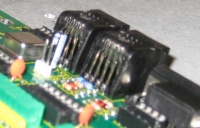
|
|
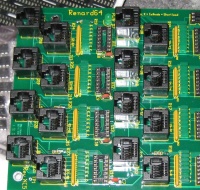
|
|
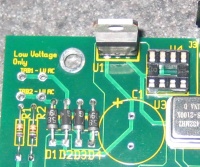
|
|
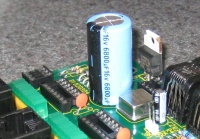
|
| |
| |
| |
| |
| |
| |